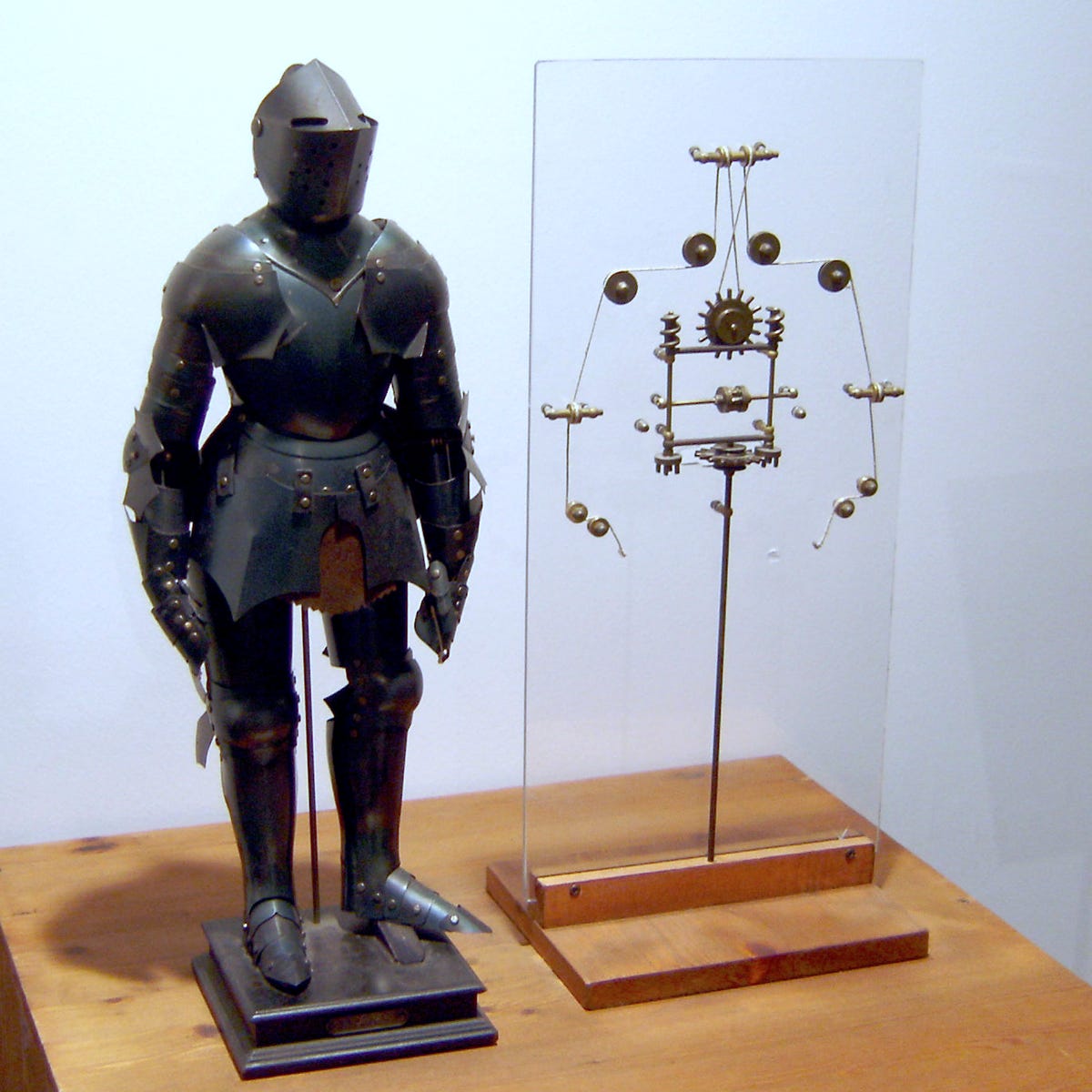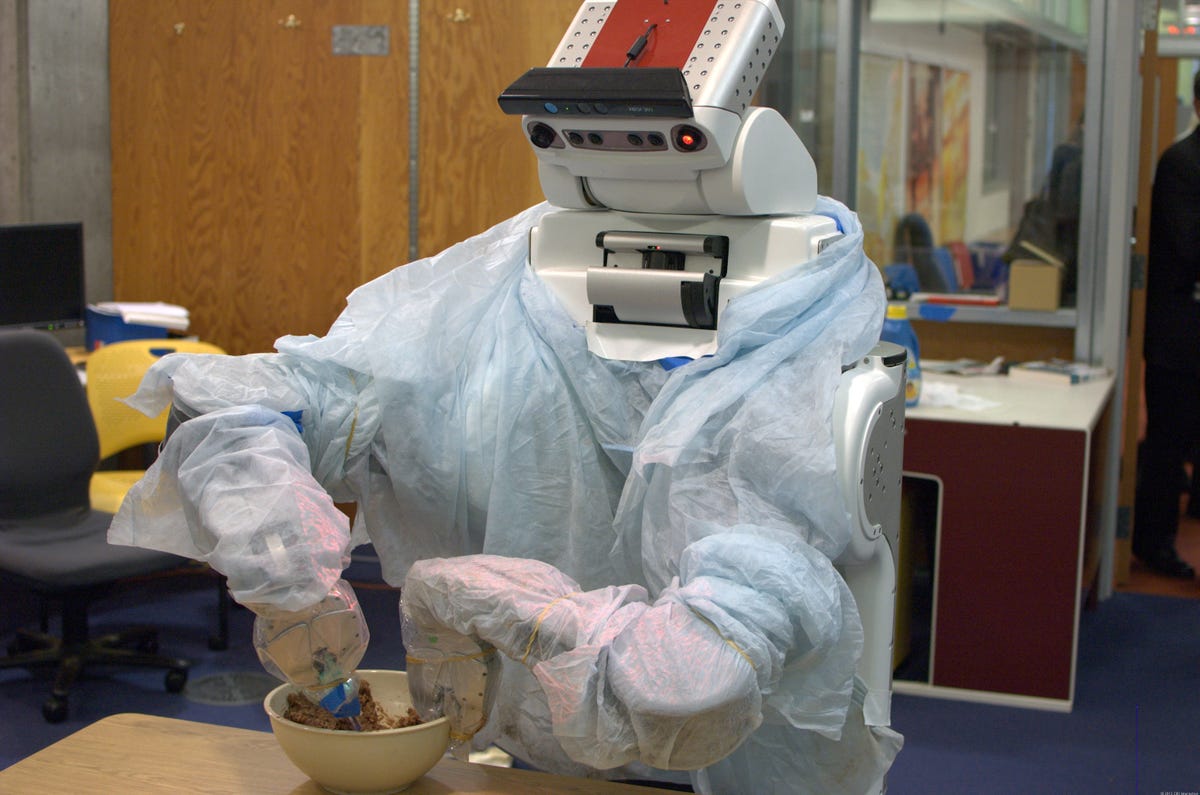Rethinking the robot through history (images)
The early days of automatons and robots were often viewed as mechanized humans, but today's robots come in a wide variety of shapes and address a growing number of very specialized tasks.

Leonardo's automaton
The term "robot" didn't surface in general usage until the 1920s. But as far back as the late 15th century, there is evidence of an automaton. Leonardo da Vinci designed an automaton that made similar motions to humans by walking, sitting down, and raising its arms, according to Leonardo-da-vinci-biography.com. Operated entirely by cranks and pulleys, it is thought that da Vinci spun a crank to make a knight armor move. This photo is a replica built based on his papers. See related story, Robot companies come to bury C-3PO.
Tesla's remote controlled boat
Famed inventor Nikola Tesla demonstrated a remote-controlled boat in 1898, an event some consider the birth of robotics. The boat, which operated in a specially built tank at an electrical exhibit in New York, was controlled by radio and operated on an internal battery. At the event, Tesla declared the boat is the "first of a race of robots, mechanical men which will do the laborious work of the human race," according to PBS.
Maria from Metropolis
In popular culture, though, robots have been very human like. The first robot to come onto the silver screen was Maria the robot from the movie "Metropolis," which came out in 1927. This character, plays a central role in the film's dystopian vision of the future in which humans and robots are in conflict. Maria is considered a direct predecessor of C-3PO of "Star Wars" fame and other humanoid robots.
Bristol turtles
In the late 1940s, a British neurologist named Grey Walter started tinkering with small machines that could operate autonomously. He built two turtles, named because of their shell, which would move around a room and avoid bumping into objects and even return to a base to charge batteries. Although limited, these simple machines were a leap in robotics because they operated without preset directions. Here's a video of Walter and the "Bristol turtles" at work, and here is more information on the history of the original machines.
iRobot and Robby the Robot
In 1942, science fiction writer Issac Asimov spelled out his three rules of robots in which any robot must obey humans, must not harm humans, and must protect itself without breaking the first two rules.
This marked a shift in thinking about robots in that Asimov deliberately wrote stories, such as "I, Robot," where robots didn't turn on their creators and try to take over the world.
Characters, such as Robbie the Robot (pictured here), appeared in the mid-1950s and played roles in which they aided their human companions.
Unimate gets to work
In the early 1960s, robots started making a mark on the factory floor. Pictured here is Unimate, the first industrial robot, which was used by General Motors at an auto manufacturing plant. Its arm moved hot pieces of die-cast metal based on a set of step-by-step instructions stored on a magnetic drum. Eventually, the platform was adopted for the production of TV picture tubes and other factory tasks.
Shakey works the room
The dawn of the computer age opened up new possibilities in robotics. Shakey, a robot developed by SRI International in the 1960s, was mobile, had a television camera for computer vision, touch sensors, and was connected via a radio link to a minicomputer. It never became a practical product, but Shakey and mobile robots like it gave researchers a platform for developing software for navigating an unknown space, as well as other artificial intelligence applications, according to the Computer History Museum.
Aibo robot dog
Japan has been the home to many well-known robots, including the robot dog Aibo from Sony (pictured here) and Honda's humanoid Asimo robot. Neither of those products is manufactured today, but both have been key figures in popular robots. This photo shows how Aibo was used in a robot soccer-playing competition, which continues today with different robotic platforms.
Kismet greets Cynthia
In the late 1990s, MIT launched a project to study social interactions between humans and robots. Pictured here is Kismet with creator Cynthia Breazeal. With its human-like face, Kismet can express various emotions based on human cues. For facial dexterity, the robot was equipped with four separate motors on its lips, multiple cameras to enable peripheral vision, and a microphone in its ear.
Exoskeleton bot
The military has long been one of the primary customers for robotics, including thousands of small unmanned ground vehicles (SUGVs) deployed now in Iraq and Afghanistan to search for explosives. Seen here is the Berkeley Lower Extremity Exoskeleton (BLEEX), an example of an exoskeleton that augments a person's ability to carry heavy loads. The purpose of this project, funded originally by DARPA in 2000, is to allow a person to carry a heavy load for long period while ensuring good movement and dexterity.
Warehouse fulfillment
It's a far cry from Asimo or other entertainment-oriented robots, but Kiva Systems' warehouse delivery system is a successful commercial product. The robots can navigate a warehouse to find and deliver objects for e-commerce fulfillment. Amazon has purchased Kiva Systems for $775 million, an indication of how automation is strategic to Amazon.
Ava robot
iRobot is best known for its Roomba vacuum cleaner and the array of SUGVs it supplies to the military. The company is now betting on another platform called Ava, which is a mobile robot that uses a tablet computer as a human interface. The first applications for Ava will be in telemedicine, building security, and retail.
Computerized quadcopter
A common platform for robotics software development are quadrotors, or helicopters with four propellers. In a recent presentation, a team from the University of Pennsylvania demonstrated a group of these quadcopters working in unison to play musical instruments, a video that quickly went viral. Seen here is robotics researcher Kenn Sebesta flying a development quadcopter.

PR2 bakes a cake
Another popular robot for research and development is Willow Garage's PR2, pictured here mixing cookie batter at MIT. With wheels, two arms, and cameras, it can navigate autonomously. Inside the PR2 is open-source software geared at creating a more common platform for programming robots, which often have proprietary software. Note how this PR2 is augmented with a Microsoft Kinect game console controller on its "head" to give it three-dimensional vision.
Laundry-folding robot
Who wouldn't want a robot to fold their laundry? Cleaning is certainly one of the most interesting uses of consumer robots--millions of robotic vacuum cleaners have already been sold. But this Cal Berkeley project addresses computer vision, one of the toughest challenges of robots. A research team developed software for a Willow Garage PR2 that allows it to recognize and fold towels. Special techniques need to be developed for handling objects with no set shape, which are much harder for robots to recognize.
Bots of the sea
Robots are also making a mark in the water. Pictured here is the Wave Glider from Liquid Robotics. It is a robot able to operate autonomously for months at a time at sea, powered by solar panels and the motion of waves. The device is being used to gather information about the oceans, such as the acoustic impact on mammals, or for defense and security. Among the employees at Liquid Robotics is James Gosling, one of the inventors of Java and the former chief technology officer of Sun Microsystems.
The surgeon's robot will now see you
There are a number of potential uses of robotics in health care, including prosthetic limbs, medical capsules, and caring for elderly people. Seen here is robotic-assisted surgery, in which surgeons use the machine to get a magnified view of the patient and to do precise movements for minimally invasive surgery.
RoboBees
RoboBees are a Harvard University project to build large numbers of very small robots that can be used for search mission after a disaster or even to pollinate crops as honeybee populations suffer. To make these small robots in large numbers, Harvard researchers have developed origami-inspired fabrication techniques designed for mass production.
Ostrich leg
Biomimcry is a clear trend in robotics development. Ian Manchester, who works in the Robots Locomotion Group at MIT, shows a prototype of Fast Runner, a robotic leg inspired by an ostrich. Moving the top hip joint with a motor (or by hand) induces a kicking motion through the entire leg.
Curiosity on way to Mars
Space missions, of course, have been one of the most challenging testing grounds for robots for many years. Pictured here is the Curiosity, an SUV-size robot that is expected to land on Mars this summer. The nuclear-energy-powered Curiosity will be essentially a mobile science laboratory to explore whether the planet has ever been able to harbor carbon-based life over the course of its existence.
Google driverless car
Google's project to build a self-driving car has gone a long way toward introducing the concept to the masses. Advances in computing are one of the main forces pushing robotics ahead -- as exemplified by Google's self-driving car.
As the car drives down the road, sensing systems collect information and can send it back to data centers for analysis. The company first disclosed work on robotic cars in 2010 and recently chauffeured a blind man to the shopping center in one such car to demonstrate the potential.
Kilobots
One of the core challenges in deploying groups of robots is programming them en masse. Harvard University has licensed its kilobot platform (kilo meaning thousands) so that researchers and hobbyists can use these simple, walking robots. The university is also working on a software system to update the software on several kilobots at once over a wireless network, making them more practical.
Robojelly
In an example of robots inspired by nature, the U.S. Navy sponsored a project to build robotic jellyfish, many of which could communicate and work in a network. The robots themselves are powered by drawing hydrogen from seawater. Pictured here is an actual jellyfish with the Robojelly.
The Robojelly could be used for surveillance or environmental monitoring.
Robotic recycler
Beyond the technical challenges, there is a need to make robots that address pressing business needs and specific problems. Seen here is a robot from startup Zen Robotics that is designed to recognize and sort recyclable waste.

